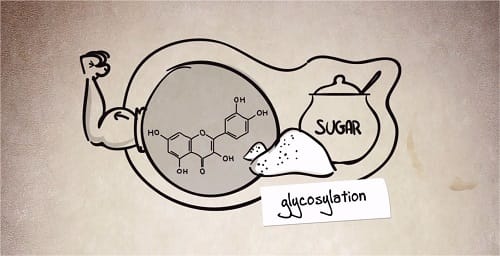Linking a sugar moiety to small molecules alters their physicochemical properties, which can lead to a myriad of interesting applications. However, glycoside synthesis is no child’s play and was deemed unprofitable by the chemical industry. This is about to change as Ghent University’s EU research project ‘Novosides’ has created new biocatalytic production methods.
The beneficial properties of glycosylation have been known for a long time, including an increased solubility, an altered activity spectrum of antibiotics, an increased stability of vitamins or anti-oxidants, and more favourable drug pharmacokinetics. For example, menthol glycosides are more soluble in water, opening up their range of applications to foodstuffs, toothpastes and gargling solutions, as emulsifiers or solvents are no longer needed (1). A beneficial side effect is a longer lasting, gradual release of the mint-flavour as the glycosidic bond is enzymatically cleaved in the mouth.
Enzymes for cleaner production processes
Traditionally, chemical glycosylation methods require long multi-step procedures, resulting in a low yield. They also lack selectivity, and use toxic catalysts, leading to a high amount of waste products. In contrast, enzymatic glycosylation reactions have been reported to generate 5-fold less waste with a 15-fold higher space-time yield (2). However, their application is hampered by the limited availability of enzymes capable of glycosylating diverse small molecules from readily available glycosyl-donors. Furthermore, the enzymes need to be reasonably stable in industrially relevant process conditions, and remain active in the presence of solvents, as these are needed to solubilize the desired acceptors.
These were the challenges the Novosides project wanted to overcome. In a partnership with the Academy of Sciences of the Czech Republic, the University of Groningen and the University of Jena, together with industry partners BioBase Europe and Carbosynth, researchers from Ghent University obtained funding from the Seventh Framework Programme of the European Union.
Sampling nature
Through sampling of natural environments and mining of public (meta)genome databases, 50 different carbohydrate active enzymes were collected and tested. The best results were obtained with a sucrose phosphorylase, glucansucrase and rutinosidase. These were shown to be active on a wide range of chemical compounds, including some previously unreported reactions. Glycosylation of simple aliphatic alcohols such as hexanol up to more complex, medically relevant anti-oxidants such as resveratrol or quercetin, was achieved using cheap donor substrates such as sucrose. Other glycosylated small molecules included vitamins (ascorbic acid), flavours and fragrances (vanillin, geraniol) (3).
Although the enzymes were able to glycosylate many compounds, the selected enzymes were not sufficiently stable to withstand industrial process conditions. Through enzyme engineering, six mutations were discovered that resulted in a two-fold increase in the stability of the sucrose phosphorylase, enabling its application in a production process.
A viable future for industrial scale glycosylation
The production processes of 2-glucosyl pyrogallol, catechol glycosides and isoquercitrin were subsequently scaled-up in the Bio Base Europe Pilot Plant. Commercial grade products were obtained in kilogram amounts and added to the catalogue of project partner Carbosynth. The process for isoquercitrin is particularly promising as market forecasts indicate its worldwide demand will rise to the 100-ton scale within a few years, thanks to its demonstrated health benefits. The Novosides technology can make this happen as its process is viable at the projected price of 100€ per kilogram. Isoquercitrin used to be commercially available through traditional processes only in milligram quantities against a high price.
Thanks to the demonstration that biocatalytic glycosylation can be done at an industrial scale, this project could expand the use of enzymes in industry. With about 70% of the world’s enzyme production originating in Europe, strengthening Belgium’s position in the enzyme market could have a significant economical impact. Furthermore, environmentally friendly and profitable production processes for glycosides will bring new compounds to the market in food, pharmaceutical and medical preparations.
References
(1) Patent US 4038270 A Menthol glycoside, process for preparing the same and method for releasing menthol therefrom
(2) de Roode, B. Mattheus, et al. “Perspectives for the industrial enzymatic production of glycosides.” Biotechnology progress 19.5 (2003): 1391-1402.
(3) Novosides Glycosylation Database
Watch the movie about Novosides:


